|

|
 |
|
Last Updated: Feb 6, 2017 - 2:32:04 PM |
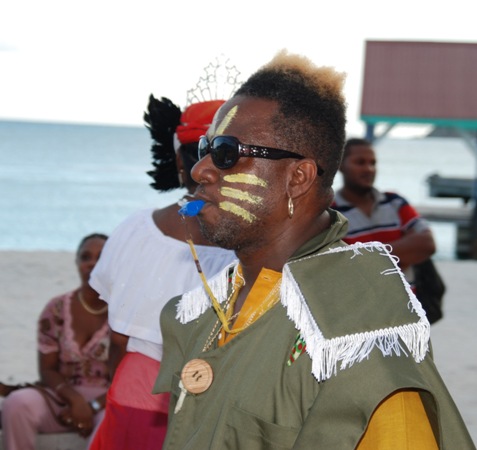
Urmain “Youmay” Dormoy on the Boardwalk. (Saltwater Collection)
|
Great Bay, St. Martin - The moko jumbie or stiltwalker is making a spectacular come back in St. Martin’s festive and masquerade culture. This legendary folk persona had all but disappeared from the island by the late 1960s. Certainly by the early 1970s, just as the tourism boom got underway, the moko jumbie, along with traditional masqueraders, stick-fighting, quimbé, pump drum, the Ponum,* and other public-display cultural art forms appeared to have died an inglorious death.
Now, about 40 years later, a literal younger generation of St. Martiners are raising this cultural giant back to life. In 2011, Tyrone Phelipa led a stout band of male and female moko jumbies, towering over the streets and fellow revelers for the largest of the nation’s two carnivals.
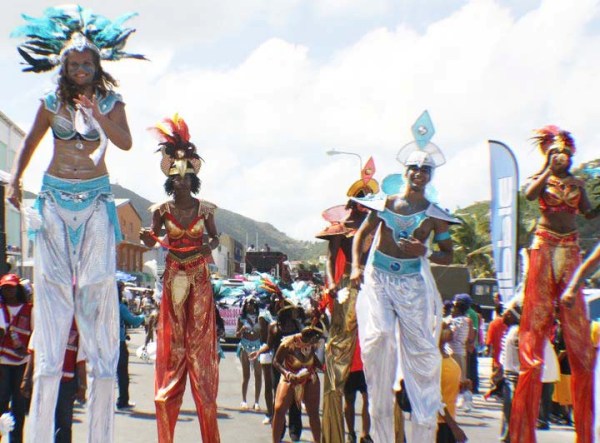
Tyrone Phelipa (2nd from R) with fellow stiltwalkers towering over revelers for Carnival 2011 on the WJA
Nisbeth Road. (Photo courtesy T. Phelipa)
|
In September the same band of mostly teen stiltwalkers was seen walking tall at the reportedly “impressive” cultural extravaganza in Marigot for the Caribbean Tourism Organization conference.
In the 2007 Boardwalk Mas parade, Phelipa’s Soualiga Capoeira troupe included about four adolescents on stilts. At least two of the children stood on stilts not much higher than one foot. From that first important field training came some of the teenagers who are today on their way to lording over the streets with this ancient high art.
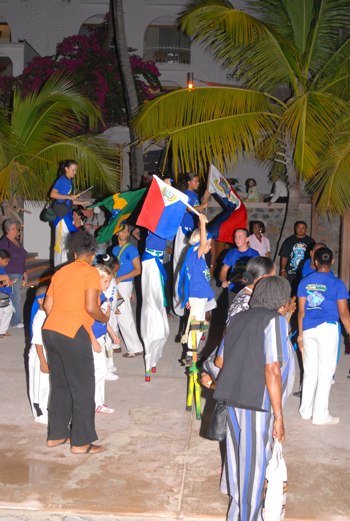
Soualiga Capoeria children on stilts about 12 inches high for Boardwalk Mas 2007. (Saltwater Collection)
|
Phelipa was inspired, no doubt, by the awe-inspiring Chagredandies, the moko jumbie troupe from St. Kitts-Nevis, who have been guests of the Boardwalk Mas since its founding in 2005 as a heritage event of the St. Maarten Tourist Bureau (STB). The
fantastically agile Chagredandies tower up to 14 feet tall on stilts as they walk, dance,
and perform breathtaking acrobatic moves in the Boardwalk Mas parade.
The St. Martin festival features, including old-time masqueraders, folkloric creatures, and stiltwalkers, have contributed to making the Boardwalk Mas a unique spectacle. The features are based on research prepared by House of Nehesi Publishers (HNP) that was proposed to STB. The tourism agency subsequently invited HNP to coordinate the mas.

Soualiga Capoeria teens on moko jumbie stilts for Boardwalk Mas 2010. (Saltwater Collection)
|
HNP proposed to invite moko jumbies only for the opening year. Each year thereafter a different traditional arts persona or group from the Caribbean region would be invited to perform in the parade or concert of the mas as a special guest.
But the man who insisted on an annual appearance of the mokos was the parade manager, a practical cultural field marshal, Urmain “Youmay” Dormoy. HNP brought
Youmay in on the Boardwalk Mas project. His job: to find groups and performers and to
manage the parade with a loyal focus on traditional St. Martin features at the core of the mas.
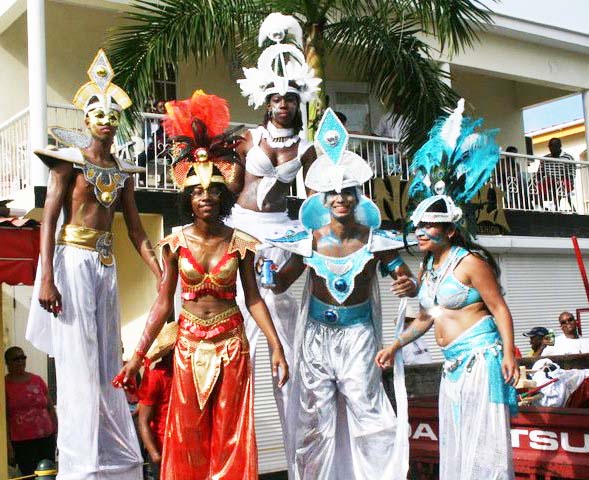
Soualiga Capoeria moko jumbies in carnival costume, two reaching above the veranda of a two-story house
for Carnival 2011. (Photo courtesy T. Phelipa)
|
In 2005, Youmay contacted colleagues in the cultural department of neighboring St. Kitts-Nevis, looking for expert moko jumbies.
The Chagredandies were located, invited, and became an instant hit on The Boardwalk. Youmay insisted on inviting the group every year since then. His consistency has arguably paid off with St. Martin’s own novice stilt artists emerging out of Soualiga Capoeira’s initiative and exercises. This has allowed spectators to enjoy our own children carrying on an admirable art form that demands great discipline and coordination to master.
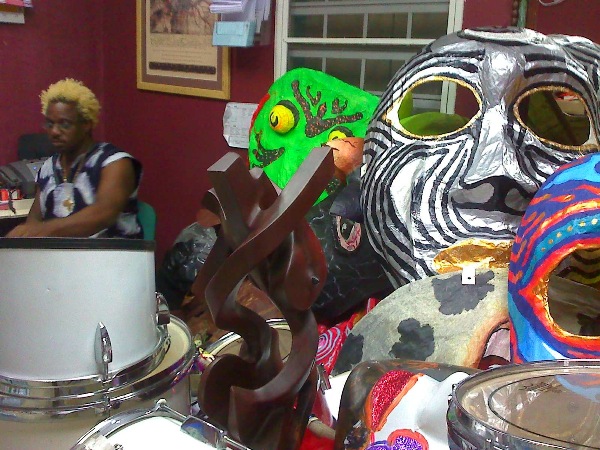
“Youmay” Dormoy (L), with marching drums and handcrafted masks, preparing for the Boardwalk Mas,
Cultural Center, 2010. Photo: Lasana M. Sekou
|
In 2010, with both Chagredandies and Soualiga on the road, Youmay added a fledgling group of teen stiltwalkers from Anguilla, thus enhancing the authenticity and popularity of the mas on the Great Bay Beach Promenade as a family-oriented exhibition of traditional St. Martin and Caribbean parade art forms.
You may might be remembered, although barely, for his role in the “Art Invasion” project over 10 years ago, which threatened to turn this city into a virtual art gallery. But he is certainly better known as the pied piper of the much-in-demand Generation New Status Drum Band. Founded in 2009, this irrepressible marching band has over 60 members, mostly children, who often don highly creative old-time and somewhat avantgarde costumes and masks as part of their spirited performances. (The GNS band was itself inspired by the Boardwalk Mas, Youmay’s dedicated work with marching bands, and his pre-2005 dream to host a competitive regional drum band fest annually.)
It should be noted that in 2006 Youmay had plans to organize stiltwalking workshops for groups from each district in the South, to be conducted at the Cultural Center by visiting experts. The STB head at that time, Regina Labega, was most enthusiastic about the idea and was ready to lobby for its sponsorship through the department. But before the workshops could get underway, Philepa, himself an arts pioneer with staying power, had his children climbing the stilts in record time, or, as we would say, “like nobody’s business.”
According to Phelipa, he is “utilizing the resources of the Soualiga Capoeira Foundation to reinvigorate two old Caribbean traditions amongst the youth of the island: Stiltwalking and String Band Music.”
Trinidad, St. Kitts-Nevis, The Bahamas, and St. Thomas are among the countries and territories where the ancient moko jumbie has remained, evolved, or was revived as a staple of popular or national culture. Important to the success of keeping this cultural
feature on the scene is the private initiative that organizes the performance groups.
Some troupes are linked to or work closely with the cultural departments of their
country or territory. Some are contracted to travel for tourism trade shows or regally
represent their nation in regional and international festivals and competitions.
The more impressive moko jumbies not only dress in colorful costumes, but also wear ornate, even menacing, elongated masks, horns, layers of clothing embedded with
cowrie shells and cow bells, straw and the like; aspects of the five elements and of the
male and female gender.
The elaborate headdresses of the mokos give them far more dramatic heights and
appearances than stilts alone would allow. Some of these jumbies can reach up to 20 feet tall. The stiltwalkers in the Caribbean and in other African Diaspora regions of the
Americas descend mostly from West African traditions. The imposing costuming, masks, and headdresses are probably patterned after distant “memories” of West African secret societies, ritual keepers of the old art for hundreds of years.
In West Africa stiltwalkers or “stiltdancers” go by names like Agere, Nyon Kwoya, and Chakaba (some are so dread they must remain nameless!), wear sacred masks, and are accompanied by elite drummers. They protect the village or town by symbolically or metaphorically chasing away evil and calling forth blessings of goodness and good cheer during festivals.
Over at least the last 300 years in the Caribbean, elements specific to the cultures and experiences of the region have been added to the images of the moko jumbie that persist to this day. Indeed, stiltwalking and stiltdancing forms are found in many parts of the world. As a universal phenomenon for millennia, jesters and shepherds, royal guards and mailmen are among those who have strapped on the long wooden or bamboo “legs” down the ages.

© Copyright 2011 by thebahamasweekly.com
Top of Page
|
|
 |

|
